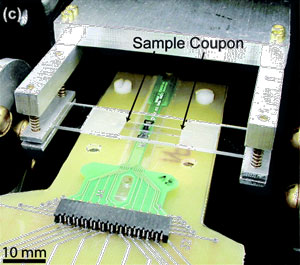| Posted: October 22, 2008 |
Toward non-invasive disease diagnosis with 'wellness cards' |
|
(Nanowerk News) Scientists are reporting development of a device that could serve as the electronic “reader” for a coming generation of “wellness cards,” specimen holders used to diagnose disease from a drop of a patient’s saliva or blood.
|
|
The research, done by scientists in Utah, Iowa, Arizona, and Minnesota, is presented in two papers scheduled for the November 1 issue of ACS’ Analytical Chemistry, a semi-monthly journal ("Giant Magnetoresistance Sensors. 1. Internally Calibrated Readout of Scanned Magnetic Arrays" and "Giant Magenetoresistive Sensors. 2. Detection of Biorecognition Events at Self-Referencing and Magnetically Tagged Arrays").
|
|
In those studies, Marc Porter and colleagues describe using the same technology at the heart of miniaturized hard disk drives to create the new rapid-screening sensor. Using a phenomenon known as giant magnetoresistance (GMR), the device can detect samples on much smaller areas compared to older technologies, the papers note.
|
 |
| A new electronic reader could provide disease diagnosis from a small amount of a patient's saliva or blood. (Image: American Chemical Society)
|
|
As a test, Porter demonstrated the GMR sensor could detect as few as 800 magnetic beads with microscopic dimensions. “Several laboratories have begun to transition GMRs from the data storage domain to that of the bioanalytical sciences,” the paper states. “We believe that, by leveraging advances made in the magnetic recording industry (for example portable digital music players), a robust, field-deployable, assay device capable of sensing single-binding events is just over the horizon.”
|

